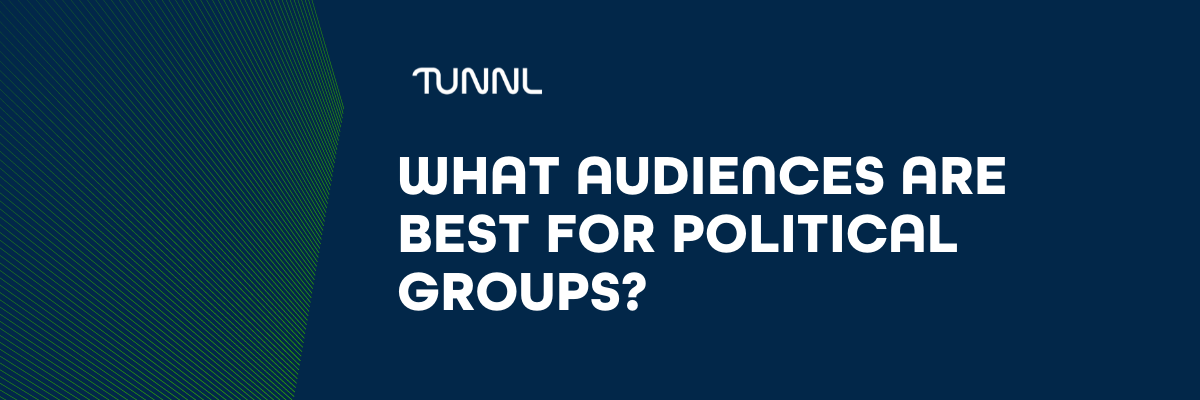What Audiences Are Best for Political Advertisers?

Political advertisers understand better than most the weight of public opinion, especially in today’s tense social climate. These marketers need to have a constant pulse on public opinion as they wade into challenging societal issues.
Without deep insights into what their base looks like and how they are feeling across various issues, political advertisers’ messaging can come off as out of touch, insincere, or even callous.
Tunnl’s audience insights provide a roadmap to marketers creating the perfect outreach strategy. When you know the detailed human insights on your target market, you can more easily craft messaging that addresses their deepest concerns and values.
In this article, we identify the most beneficial prebuilt Tunnl audiences for marketers who are responsible for crafting political advertising. With the audiences listed here, political advertisers can better understand their voter base and reach them where they can make the greatest impact.
Political Audiences #1–4: Swing Voters (General, Women, Seniors, Likely)
Every election cycle sees Democrats and Republicans battling it out, with each side relying on their respective party members to vote them into office. However, there’s another voter group that is just as influential to political campaigns’ efforts: swing voters.
This elusive group is made up of people who are undecided on whom they will vote for, and are generally receptive to messages from both sides. These individuals are more likely to vote with their conscience, or whichever political candidate aligns more with their own personal opinions and values.
Tunnl has created four audiences to target this group:
- Swing Voters: Voters who are likely undecided on the upcoming election and are receptive to messages from both parties.
- Swing Women: Female voters who are likely undecided on the upcoming election and are receptive to messages from both parties.
- Senior Swing: Voters over the age of 65 who are likely undecided on the upcoming election and are receptive to messages from both parties.
- Soft D, Soft R, or Swing Likely Voters: Voters who lean Democratic or voters who lean Republican, but may be undecided.
“While appealing to your voter base is critical to the success of your campaign, you can’t underestimate the power of flipping swing voters,” says Nate Romberg, Tunnl’s Senior Director of Business Development.
With the insights provided by these audiences, you will be maximally equipped to appeal to undecided voters on the causes you’re championing.
Political Audiences #5–6: Low Turnout Voters (Republican, Democrat)
There have been a number of American elections won by just a few hundred votes. When every vote counts, advertisers need to reach and motivate not only their political base, but those voters who rarely make it to the polls in the first place.
Winning over a few hundred voters can be the only difference between a historic win and a devastating loss.
Consider the 2016 presidential election, wherein only an estimated six in ten eligible voters cast ballots. Voter turnout in this election ranged from a mere 42% to 74%, depending on the state. Had the Democratic side stressed the importance of their vote to lower turnout voters, it’s possible the election could’ve gone a different direction.
Tunnl has two audiences to help you better understand these low turnout voters through deep, human insights:
- GOP GOTV (“get out the vote”): Low and mid-turnout Republican voters.
- DEM GOTV (“get out the vote”): Low and mid-turnout Democratic voters.
The insights provided in these two audiences will help you craft messaging that addresses issues that matter most to low-turnout voters from both parties, as well as guide you on the most beneficial channels to place your messaging so these important voters see it and are influenced to act.
Political Audiences #7–9: Minority Voters
The United States has always been a melting pot of heritages. Experts project that the year 2030 and beyond will see the population continually become more racially and ethnically diverse.
It’s important for political campaigns to understand this fact and appeal to every American across demographics. Not doing so risks election losses and the fallout of being labeled “tone deaf,” “out of touch,” or worse.
“Minority populations have battled through voter suppression and more, and their votes are incredibly important,” says Nate. “These are communities that need to be heard. If political campaigns want their trust and their vote, they need to appeal to them on a personal level.”
Tunnl has several prebuilt audiences that help political advertisers understand minority voters on this personal level, activating them to vote. Three of them are . . .
- Hispanic Persuadables: Hispanic voters who do not consistently fall along party lines and are receptive to messages from both parties.
- Black Voters: Likely African American voters nationwide.
- Asian Voters: Likely Asian voters nationwide.
Tunnl's minority group audiences allow political advertisers the chance to understand key cultural differences, so that they can respect as well as understand them on a core level. Only then can political advertisements begin appealing to these important voters' core issues and values. The audiences provided above offer a window into these communities so you can begin crafting messages that make a difference.
Need a Political Audience That's Not Listed Here?
Didn’t find your ideal political audience recommended in this article? Here are your options for next steps.
Peruse the rest of Tunnl’s prebuilt audiences
Tunnl has a library of hundreds of prebuilt audiences centered around niche groups and top-of-mind issues. Explore our prebuilt audience library to see if your perfect audience is available for activation in your campaign.
If you don't find your ideal audience in our prebuilt library...
Sometimes advertisers have an extra-niche group they need to reach. If you find that Tunnl doesn’t have your ideal audience readily available in our prebuilt library, we can build a custom audience for you.
Learn more about custom audience subscriptions and whether they’re the right move for your political group.



